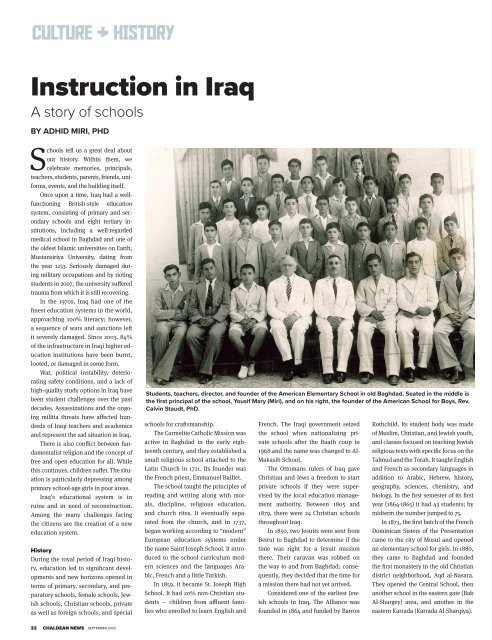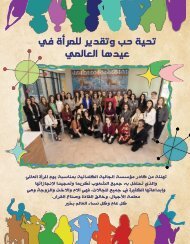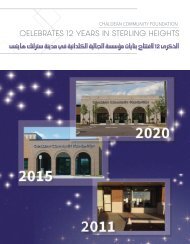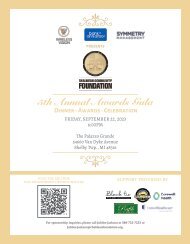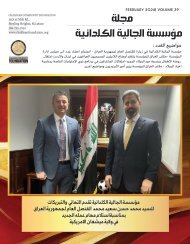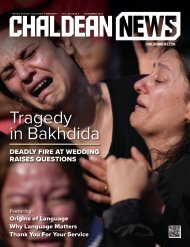You also want an ePaper? Increase the reach of your titles
YUMPU automatically turns print PDFs into web optimized ePapers that Google loves.
CULTURE & HISTORY<br />
Instruction in Iraq<br />
A story of schools<br />
BY ADHID MIRI, PHD<br />
Schools tell us a great deal about<br />
our history. Within them, we<br />
celebrate memories, principals,<br />
teachers, students, parents, friends, uniforms,<br />
events, and the building itself.<br />
Once upon a time, Iraq had a wellfunctioning<br />
British-style education<br />
system, consisting of primary and secondary<br />
schools and eight tertiary institutions,<br />
including a well-regarded<br />
medical school in Baghdad and one of<br />
the oldest Islamic universities on Earth,<br />
Mustansiriya University, dating from<br />
the year 1233. Seriously damaged during<br />
military occupations and by rioting<br />
students in 2007, the university suffered<br />
trauma from which it is still recovering.<br />
In the 1970s, Iraq had one of the<br />
finest education systems in the world,<br />
approaching 100% literacy; however,<br />
a sequence of wars and sanctions left<br />
it severely damaged. Since 2003, 84%<br />
of the infrastructure in Iraqi higher education<br />
institutions have been burnt,<br />
looted, or damaged in some form.<br />
War, political instability, deteriorating<br />
safety conditions, and a lack of<br />
high-quality study options in Iraq have<br />
been student challenges over the past<br />
decades. Assassinations and the ongoing<br />
militia threats have affected hundreds<br />
of Iraqi teachers and academics<br />
and represent the sad situation in Iraq.<br />
There is also conflict between fundamentalist<br />
religion and the concept of<br />
free and open education for all. While<br />
this continues, children suffer. The situation<br />
is particularly depressing among<br />
primary school-age girls in poor areas.<br />
Iraq’s educational system is in<br />
ruins and in need of reconstruction.<br />
Among the many challenges facing<br />
the citizens are the creation of a new<br />
education system.<br />
History<br />
During the royal period of Iraqi history,<br />
education led to significant developments<br />
and new horizons opened in<br />
terms of primary, secondary, and preparatory<br />
schools, female schools, Jewish<br />
schools, Christian schools, private<br />
as well as foreign schools, and special<br />
Students, teachers, director, and founder of the American Elementary School in old Baghdad. Seated in the middle is<br />
the first principal of the school, Yousif Mary (Miri), and on his right, the founder of the American School for Boys, Rev.<br />
Calvin Staudt, PhD.<br />
schools for craftsmanship.<br />
The Carmelite Catholic Mission was<br />
active in Baghdad in the early eighteenth<br />
century, and they established a<br />
small religious school attached to the<br />
Latin Church in 1721. Its founder was<br />
the French priest, Emmanuel Baillet.<br />
The school taught the principles of<br />
reading and writing along with morals,<br />
discipline, religious education,<br />
and church rites. It eventually separated<br />
from the church, and in 1737,<br />
began working according to “modern”<br />
European education systems under<br />
the name Saint Joseph School. It introduced<br />
to the school curriculum modern<br />
sciences and the languages Arabic,<br />
French and a little Turkish.<br />
In 1859, it became St. Joseph High<br />
School. It had 20% non-Christian students<br />
— children from affluent families<br />
who enrolled to learn English and<br />
French. The Iraqi government seized<br />
the school when nationalizing private<br />
schools after the Baath coup in<br />
1968 and the name was changed to Al-<br />
Makasib School.<br />
The Ottomans rulers of Iraq gave<br />
Christian and Jews a freedom to start<br />
private schools if they were supervised<br />
by the local education management<br />
authority. Between 1805 and<br />
1879, there were 24 Christian schools<br />
throughout Iraq.<br />
In 1850, two Jesuits were sent from<br />
Beirut to Baghdad to determine if the<br />
time was right for a Jesuit mission<br />
there. Their caravan was robbed on<br />
the way to and from Baghdad; consequently,<br />
they decided that the time for<br />
a mission there had not yet arrived.<br />
Considered one of the earliest Jewish<br />
schools in Iraq, The Alliance was<br />
founded in 1864 and funded by Barron<br />
Rothchild. Its student body was made<br />
of Muslim, Christian, and Jewish youth,<br />
and classes focused on teaching Jewish<br />
religious texts with specific focus on the<br />
Talmud and the Torah. It taught English<br />
and French as secondary languages in<br />
addition to Arabic, Hebrew, history,<br />
geography, sciences, chemistry, and<br />
biology. In the first semester of its first<br />
year (1864-1865) it had 43 students; by<br />
midterm the number jumped to 75.<br />
In 1873, the first batch of the French<br />
Dominican Sisters of the Presentation<br />
came to the city of Mosul and opened<br />
an elementary school for girls. In 1880,<br />
they came to Baghdad and founded<br />
the first monastery in the old Christian<br />
district neighborhood, Aqd al-Nasara.<br />
They opened the Central School, then<br />
another school in the eastern gate (Bab<br />
Al-Shargey) area, and another in the<br />
eastern Karrada (Karrada Al-Sharqiya).<br />
32 CHALDEAN NEWS <strong>SEPTEMBER</strong> <strong>2023</strong>


